10 Best Programming Language for AI
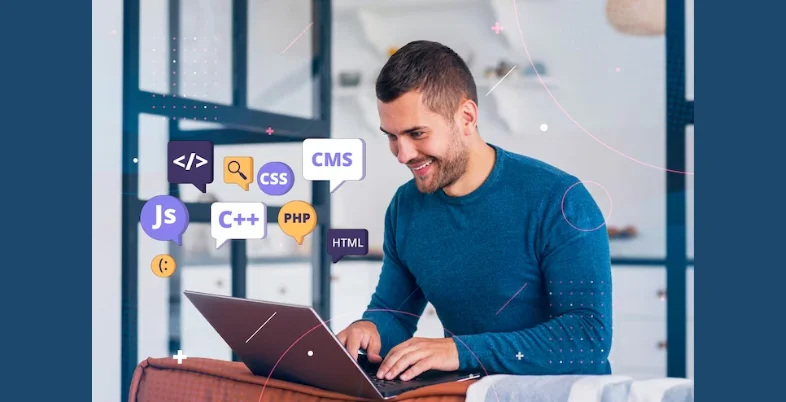
Choosing the best programming language for AI depends on various factors like the task at hand, familiarity, and the specific AI techniques you’re using.
Python stands out as a popular choice due to its simplicity, readability, and extensive libraries tailored for AI and machine learning tasks. Libraries provide powerful tools for building and training neural networks.
Additionally, Python’s versatility allows seamless integration with other technologies, facilitating AI deployment across different platforms and environments. However, languages like R, Java, and C++ also have their merits, with R excelling in statistical analysis and Java/C++ offering speed and efficiency for certain AI applications.
Ultimately, the best language depends on your project’s requirements, your team’s expertise, and the specific demands of the AI task you’re tackling.
Why Programming Language is Important for AI?
Programming languages are crucial for AI because they provide the tools and instructions needed to make AI systems work. Think of it like giving directions to a robot: without clear instructions, it wouldn’t know what to do. Programming languages allow developers to write code that tells AI how to process data, learn from it, and make decisions.
These languages also offer libraries and frameworks specifically designed for AI tasks, making it easier for developers to implement complex algorithms and techniques. For example, Python is widely used in AI development because it has extensive libraries, which are essential for tasks like deep learning.
Furthermore, programming languages enable AI systems to interact with other software and devices, making them more versatile and useful in various applications. Overall, without programming languages, it would be nearly impossible to create the AI systems we rely on today.
Suggested Read: Best AI Tools For Coding
Top 10 Best Programming Language for AI
1. PYTHON

Python is the most popular language for AI due to its simplicity and readability. It has many libraries that make AI development easier. Python is great for both beginners and experts, offering tools for data analysis, machine learning, and deep learning.
USED FOR –
Python is like the Swiss Army knife of programming languages for AI. It’s super easy to learn and use, making it great for beginners. You can do a ton of stuff with Python, like analyzing data, teaching computers to learn from data (machine learning), and building really smart programs (artificial intelligence). Plus, there are tons of handy tools (libraries) made just for Python that make AI projects easier.
FEATURES –
- Easy to Learn: Python’s syntax is simple and readable, making it accessible for beginners.
- Rich Libraries: It has extensive libraries like TensorFlow, Keras, and PyTorch for AI and machine learning.
- Community Support: A large, active community means lots of resources and help available.
- Versatile: Python is used in various fields, from web development to scientific computing.
- Integration: Easily integrates with other languages and technologies.
PROS –
– Easy to learn and use, making it great for beginners.
– Huge ecosystem of libraries and frameworks for AI development.
CONS –
– Slower execution speed compared to compiled languages like C++.
– Global interpreter lock (GIL) can limit concurrency in multithreaded applications.
2. R
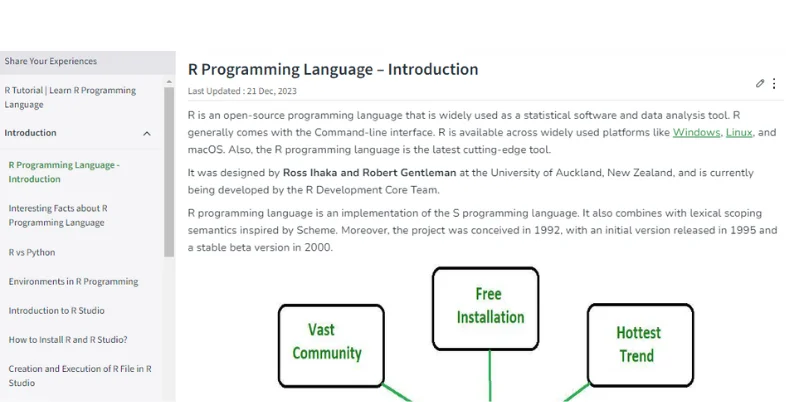
R is a language designed for statistical analysis and data visualization. It is widely used in academia and research for AI projects that involve a lot of data manipulation and statistical computations. R has numerous packages for machine learning and data mining.
USED FOR –
R is like a wizard for number crunching and data analysis. It’s used by scientists and researchers to make sense of all kinds of data. Whether it’s figuring out trends in sales numbers or predicting the weather, R has special powers (packages) that help with all sorts of statistical tasks. It’s not just about math—it’s also great at making pretty graphs to visualize data.
FEATURES –
- Statistical Analysis: Designed for statistical analysis, making it ideal for data-heavy AI tasks.
- Visualization: Excellent tools for data visualization, like ggplot2.
- Comprehensive Packages: Many packages for machine learning and data mining.
- Community Support: Strong support from the academic and research communities.
- Data Handling: Efficient in handling and analyzing large datasets.
PROS –
– Excellent for statistical analysis and data visualization.
– A rich collection of packages for data manipulation and modeling.
CONS –
– Steeper learning curve compared to more general-purpose languages.
– Not as efficient for tasks outside the realm of statistics and data analysis.
3. JAVA

Java is known for its portability and performance. It is widely used in large-scale enterprise applications. For AI, Java provides a stable environment and has libraries like Weka, Deeplearning4j, and MOA that support machine learning and neural networks.
USED FOR –
Java is like the sturdy backbone of big, important applications. It’s reliable and can handle lots of stuff at once. For AI, Java provides a solid foundation for building complex systems. Think of it like the sturdy frame of a skyscraper—without it, everything would fall apart. Java’s got special tools (libraries) for AI tasks, like analyzing data and recognizing patterns.
FEATURES –
- Portability: Java programs can run on any device with a Java Virtual Machine (JVM).
- Performance: High performance, suitable for large-scale systems.
- Robust Libraries: Libraries like Weka and Deeplearning4j support AI development.
- Scalability: Ideal for developing scalable and enterprise-level applications.
- Security: Strong security features make it suitable for secure applications.
PROS –
– Platform-independent, allowing for portability across different operating systems.
– Strong support for object-oriented programming principles.
CONS –
– Verbosity of syntax compared to languages like Python.
– Less flexibility and dynamism compared to interpreted languages.
4. C++
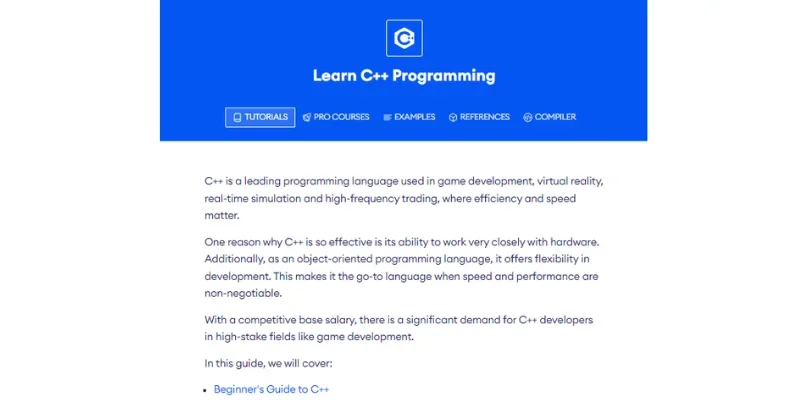
C++ is a powerful language that offers high performance and control over system resources. It is used in AI projects that require intensive computation, such as simulations and real-time systems. C++ is often used in gaming, search engines, and high-frequency trading.
USED FOR –
C++ is like the muscle car of programming languages—it’s fast and powerful. It’s used for really intense stuff, like running video games and controlling robots. For AI, C++ is perfect when you need speed and efficiency. It’s like the engine that drives AI applications, especially ones that need to make lightning-fast decisions or process huge amounts of data.
FEATURES –
- High Performance: Provides speed and efficiency, critical for computation-heavy AI tasks.
- Control: Offers detailed control over system resources.
- Real-time Systems: Excellent for real-time applications like gaming and simulations.
- Memory Management: Allows for manual memory management, optimizing performance.
- Extensive Libraries: Libraries like Caffe for deep learning support AI development.
PROS –
– High performance and efficiency, making it suitable for resource-intensive applications.
– Close-to-the-metal control over system resources and memory management.
CONS –
– Steep learning curve, especially for beginners.
– Requires more code to accomplish tasks compared to higher-level languages like Python.
5. JAVASCRIPT

JavaScript is mainly used for web development but is becoming popular in AI through frameworks like TensorFlow.js and Brain.js. These tools allow developers to build and deploy AI models directly in web browsers, making AI more accessible.
USED FOR –
JavaScript is like the friendly neighborhood kid who can do a little bit of everything. Originally used for making websites interactive, it’s now getting into AI with cool new tools. With JavaScript, you can make AI-powered web apps that do all sorts of clever things right in your browser. It’s like having a mini AI assistant right there on the internet.
FEATURES –
- Web Integration: Runs directly in web browsers, making AI accessible online.
- Interactivity: Enhances user interfaces with AI-driven features.
- Frameworks: Libraries like TensorFlow.js enable AI model deployment in the browser.
- Community Support: Large community with plenty of resources and frameworks.
- Versatility: Used for both front-end and back-end development.
PROS –
– Widely used for web development, making it accessible for creating AI-powered web applications.
– Asynchronous programming model enables non-blocking I/O operations.
CONS –
– Limited performance compared to languages optimized for numerical computations.
– Lack of standardized support for AI-specific libraries and tools.
6. JULIA
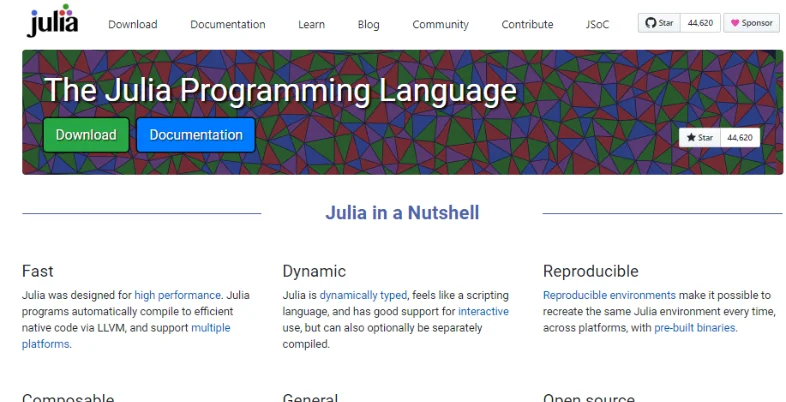
Julia is a high-performance language for numerical computing. It is designed for speed and is great for AI applications that require heavy mathematical computations. Julia’s syntax is simple, and it is especially popular in research and scientific computing.
USED FOR –
Julia is like the superhero of number crunching. It’s fast, powerful, and perfect for solving really tough math problems. Scientists and researchers use Julia to tackle all kinds of complex calculations, especially in fields like physics and engineering. For AI, Julia’s lightning speed makes it great for training and running big machine-learning models.
FEATURES –
- Speed: Designed for high performance and speed in numerical computing.
- Simple Syntax: Easy to write and understand, similar to Python.
- Mathematical Computing: Excellent for mathematical and scientific computing.
- Parallelism: Built-in support for parallel and distributed computing.
- Community: Growing community with increasing support and resources.
PROS –
– High performance on par with C and Fortran, suitable for numerical computing.
– Concise syntax and high-level abstractions for easier development.
CONS –
– Smaller ecosystem compared to more established languages like Python and R.
– Less community support and documentation for certain specialized tasks.
7. LISP
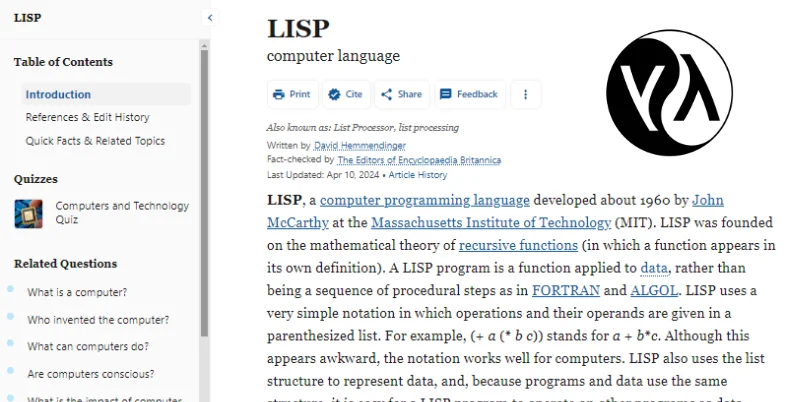
Lisp is one of the oldest programming languages and has unique features like dynamic typing and rapid prototyping. It is known for its use in AI research and development, particularly in natural language processing and symbolic reasoning.
USED FOR –
Lisp is like the wise old sage of programming languages. It’s been around forever and has a unique way of doing things. Lisp is all about symbols and logic, making it perfect for tasks that involve reasoning and problem-solving. That’s why it’s often used in AI research, especially for things like natural language processing and understanding how computers think.
FEATURES –
- Dynamic Typing: Allows flexibility in coding and quick prototyping.
- Symbolic Processing: Ideal for tasks involving symbolic reasoning and manipulation.
- Macro System: Powerful macro system for code transformations.
- Rapid Prototyping: Enables quick development of AI applications.
- History: Long history in AI, with many foundational AI systems developed in Lisp.
PROS –
– Powerful metaprogramming capabilities enable code manipulation at runtime.
– Well-suited for symbolic manipulation and AI tasks requiring complex logic.
CONS –
– Unconventional syntax and semantics may be challenging for beginners.
– Smaller user base compared to mainstream languages, leading to fewer resources and libraries.
8. PROLOG
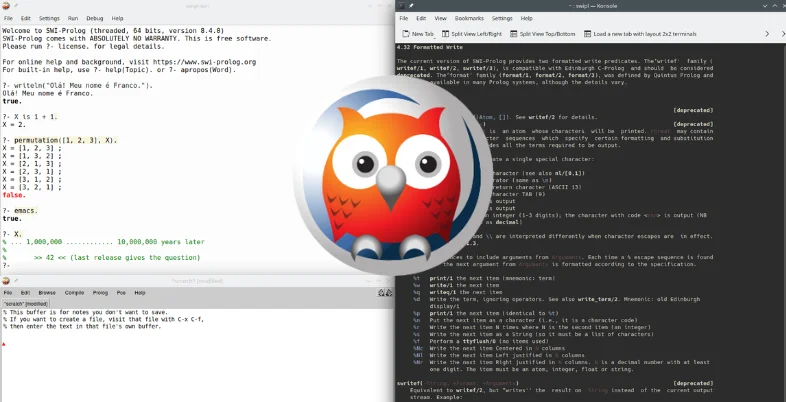
Prolog is a logic programming language used primarily in AI for tasks that involve complex logical queries and reasoning. It is effective for creating systems that need to solve puzzles, develop algorithms, or work with knowledge databases.
USED FOR –
Prolog is like the detective of programming languages. It’s great at solving mysteries and making logical deductions. In AI, Prolog is used for tasks that involve lots of rules and logic, like puzzle-solving and expert systems. It’s like having a Sherlock Holmes for computers, helping them piece together clues and make smart decisions.
FEATURES –
- Logical Reasoning: Excellent for problems requiring logical inference and queries
- Pattern Matching: Strong in pattern matching, useful in AI problem-solving.
- Rule-based: Uses rules to derive conclusions, suitable for knowledge-based systems.
- AI Focused: Designed specifically for AI tasks like natural language processing.
- Backtracking: Built-in backtracking mechanism for exploring multiple solutions.
PROS –
– Declarative programming paradigm simplifies expressing logic and rules.
– Well-suited for rule-based systems and symbolic AI applications.
CONS –
– Limited efficiency for certain types of computations compared to imperative languages.
– Steeper learning curve due to its unique approach to programming.
9. SWIFT
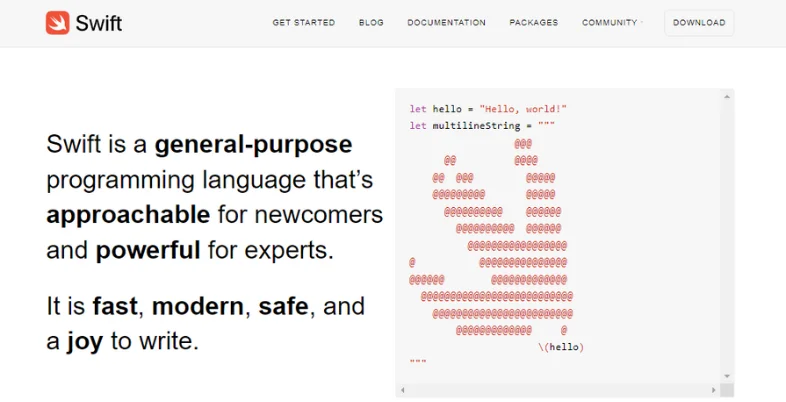
Swift is Apple’s programming language, used mainly for iOS and macOS development. With the growing popularity of AI in mobile applications, Swift has libraries like Core ML that enable developers to integrate machine learning models into their apps easily.
USED FOR –
Swift is like the cool kid on the block who’s really good at making apps for iPhones and iPads. It’s Apple’s own programming language, and it’s perfect for building sleek, user-friendly apps. With Swift, developers can add AI features to their apps, like voice recognition or image classification, making them even smarter and more useful.
FEATURES –
- Performance: High performance, ideal for mobile AI applications.
- Ease of Use: Modern and easy-to-read syntax.
- Safety: Designed with safety features to reduce common coding errors.
- Core ML Integration: Seamless integration with Core ML for machine learning on Apple devices.
- Interoperability: Works well with Objective-C and other Apple technologies.
PROS –
– Modern language designed with safety and performance in mind.
– Seamless integration with Apple’s ecosystem, making it ideal for iOS and macOS development.
CONS –
– Limited cross-platform support compared to more widely adopted languages.
– Smaller ecosystem for AI-related libraries and tools compared to languages like Python.
10. MATLAB
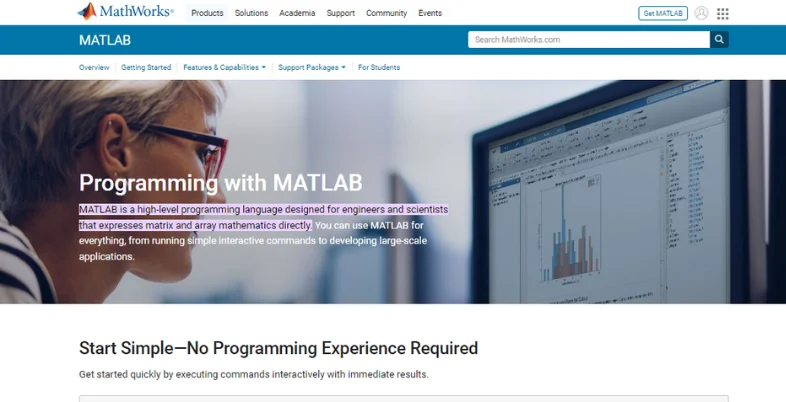
MATLAB is a high-level language and interactive environment for numerical computation, visualization, and programming. It is widely used in academia and industry for AI applications, especially in control systems, robotics, and signal processing, thanks to its powerful toolboxes.
USED FOR –
MATLAB is like the Swiss Army knife for scientists and engineers. It’s packed with tools for doing all sorts of calculations and simulations. In AI, MATLAB is used for things like analyzing signals, processing images, and controlling robots. It’s like having a super-powered calculator that can handle all kinds of complex tasks, making it indispensable for AI researchers and developers.
FEATURES –
- Numerical Computing: Strong capabilities for numerical and matrix computations.
- Visualization: Powerful tools for visualizing data and results.
- Toolboxes: Extensive toolboxes for various AI applications, like robotics and signal processing.
- Ease of Use: User-friendly with an interactive environment.
- Industry Standard: Widely used in academia and industry for engineering and scientific research.
PROS –
– Extensive toolboxes for numerical computing, signal processing, and control systems.
– Integrated development environment (IDE) with visualization tools for rapid prototyping.
CONS –
– Proprietary software with licensing costs for commercial use.
– Not as versatile for general-purpose programming compared to open-source alternatives.
Ending Note
AI is already changing how we live and work, opening up exciting opportunities for businesses and individuals. But when it comes to picking a programming language for AI projects, there’s no one-size-fits-all answer. It’s like finding the right tool for the job, depending on what you’re trying to accomplish, what tools you’re comfortable with, and what platforms you’re working on.
Python is a popular choice for AI because it’s user-friendly, has tons of useful libraries, and a big community of developers to help out. If you’re more into statistics, R is another great option. Julia is newer but gaining traction because it’s super fast and efficient. And if you’re building something that needs to be really speedy or low-level, like high-performance applications, you might want to go with C++ or C#. Each language has its strengths, so it’s all about finding the right fit for your project.